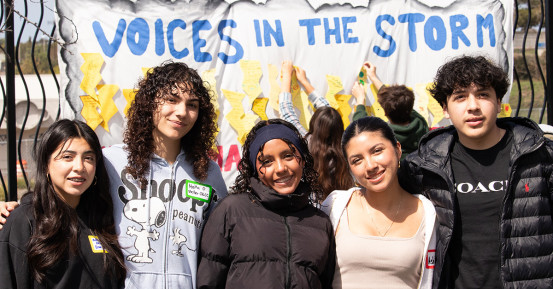By:
- Ioana Patirngenaru
Published Date
By:
- Ioana Patirngenaru
Share This:
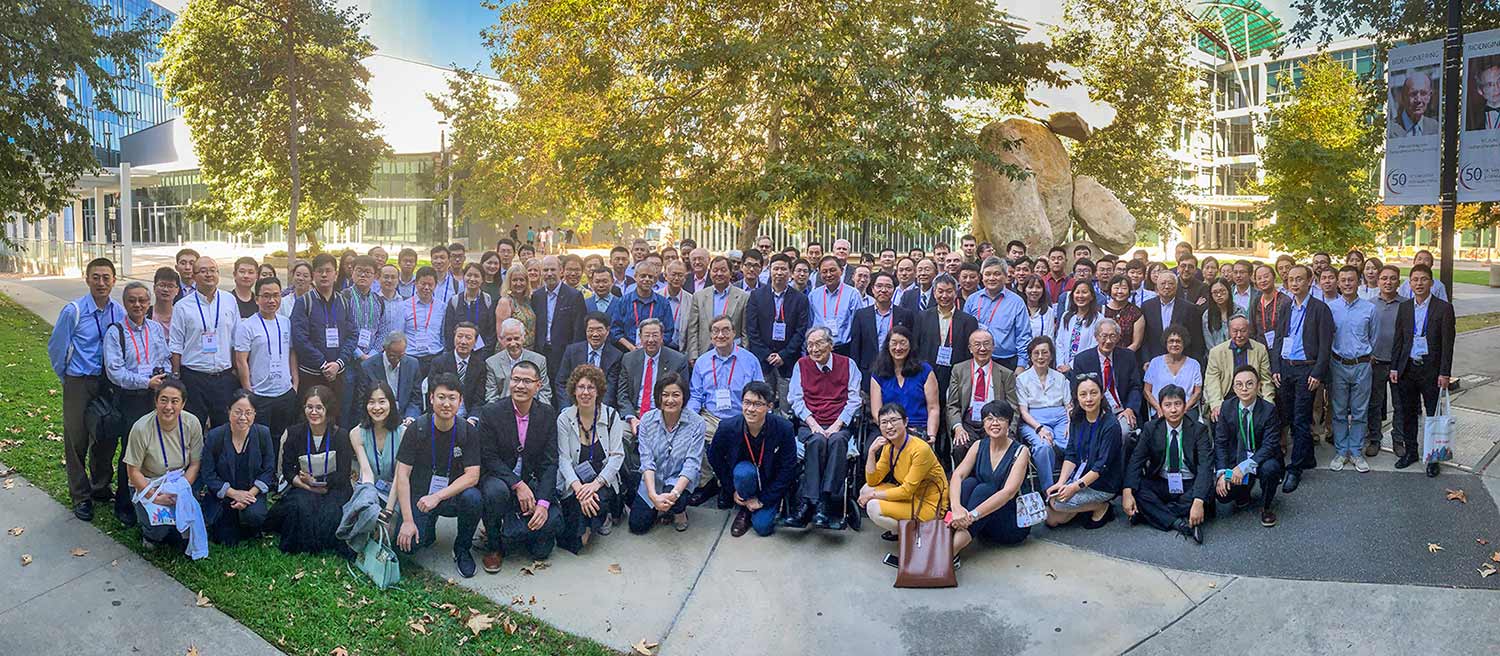
Bioengineering Pioneer Y.C. Bert Fung Turns 100
Thousands of professors, engineers, scientists and students around the world work in the field of biomechanics, the study of physics and mechanics applied to living tissues. But they are all somehow connected to Professor Y.C. “Bert” Fung at the University of California San Diego. Some use Fung’s findings in their work. Others were trained by or worked with Fung’s students. A core group studied directly under him.
Fung realized that physics and mechanics apply to living tissues just as they do to manmade structures. He is often referred to as “the father of biomechanics.”
On Sept. 21, more than a hundred researchers from as far as Israel, Taiwan, Singapore and China came together at UC San Diego to celebrate Fung’s 100th birthday. The celebration was held in the Fung Auditorium—a nod to the key role Fung played here on campus.
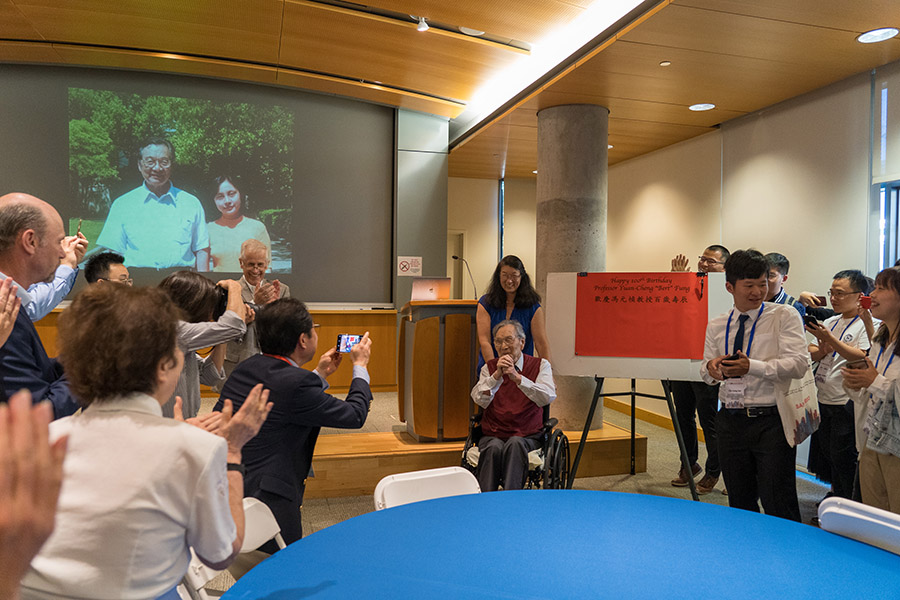
Y.C. Bert Fung (center) thanks all the bioengineering researchers who turned out for his 100th birthday celebration at UC San Diego.
He is one of the founders of bioengineering at UC San Diego, which is ranked No. 1 in the nation by the National Research Council at the National Academies. The department also has been ranked in the top five in the United States since the discipline was first ranked.
Fung received a National Medal of Science in 2000, the first bioengineer to earn the distinction. He also was the fourth individual in history elected into all three branches of the National Academies.
But of all the accolades he received, Fung’s favorite was the Founders Award he received from the National Academy of Engineering in 1998, because it was bestowed by his peers, according to his son Conrad.
In addition to his scholarship and kindness, Fung’s laugh is one of his most distinctive qualities, according to his colleagues. “He is the most joyful individual,” said Geert Schmid-Schoenbein, professor of bioengineering at UC San Diego, one of Fung’s former Ph.D. students and a key organizer of the 100th birthday celebration. “When you step into a building, you can tell where he is just by the sound of his laughter.”
Fung’s research and career
Fung moved to California from China in 1946, immediately after the end of WWII, to pursue a graduate degree in aeronautics at Caltech. He very quickly became an expert in the field of aeroelasticity—the study of the interaction of aerodynamic forces with structures that aren’t rigid. He wrote the leading textbook on the subject and led a renowned research group at Caltech.
But in 1958, while he was on sabbatical in Germany, his mother developed acute glaucoma. Fung immersed himself in all the research available on the condition at the time. He translated the latest journal articles and sent them to his mother’s physicians in China. But it quickly became evident to him that not much was known about the mechanical forces and physical phenomena to which living tissues are subjected.
“I turned to bioengineering, with a focus on people, because I felt that although we know so much about airplanes, we don’t know much about ourselves,” Fung said in a 2007 speech.
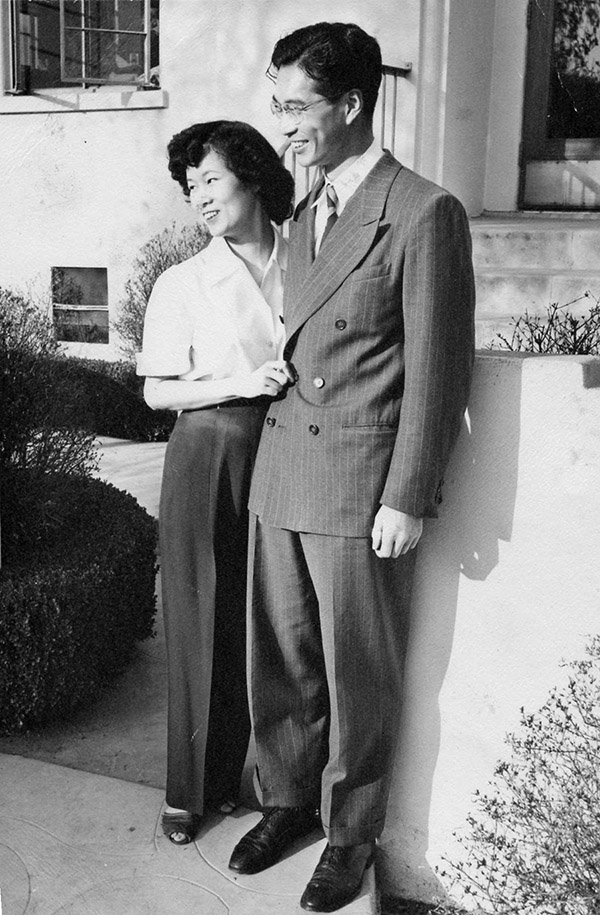
Fung and his wife, Luna, at their house in Pasadena in 1949.
It soon became clear to Fung that he needed to move to a younger university, with a medical school, where he would have more freedom to pursue the new field he envisioned. In 1966, he joined the UC San Diego engineering faculty, along with fellow researchers Benjamin W. Zweifach and Marcos Intaglietta. The three became the founding faculty members of the bioengineering program here on campus.
During the following quarter century, Fung, his colleagues and his students went on to study and analyze the mechanics at work in living tissues in everything from blood vessels, to skin, cartilage, lung tissue—and more.
“He was the first person who wanted to bring medicine and engineering together—and he succeeded,” said Peter Chen, one of Fung’s Ph.D. students who is now a research scientist here at UC San Diego.
Fung formulated the exponential law that describes how soft tissue deforms under stress. That law was later central to car safety design; all crash tests today rely on his fundamental studies of tissue response. The same law helped researchers develop artificial skin grafts that mimic the skin’s properties and are used to help burn victims heal.
Fung turned his attention to research on hypertension after his wife, Luna, developed the condition. He studied the mechanics of blood flow through microcirculation, which is the circulation of blood in the smallest blood vessels. He discovered that the motion of blood cells in the lung is similar to how cars meander in an underground parking garage. This “sheet-flow” theory provided a quantitative description of pulmonary circulation, hypertension, edema, and respiratory distress syndrome.
“After many years in the field, I really think that an interdisciplinary area is not just the one area plus another,” Fung said in an extensive oral history he recorded for IEEE in 2000. “It’s the new product in between, which is neither of the mother fields. The interesting part is the new in-between part.”
Fung as a teacher
Fung always made time for all his students. Erin McGurk was a master’s student in bioengineering at UC San Diego when she took Fung’s biomechanics class. She was struggling with one of her first homework assignments but was hesitant to ask Fung for help. He was a prominent figure in the department and had authored the textbook she was using in class. Finally, she worked up the courage to ask him a question about homework at the end of class. Fung spent two hours explaining the subject area and helping her figure out the homework problems.
“It was a pivotal moment in my career because it was a catalyst to decide that I could do this,” she said in a 2007 video made when Fung won the Russ Prize. McGurk went on to lead a biotech company that used some of the biomechanics principles discovered by Fung to develop minimally invasive devices to treat cancer, chronic obstructive pulmonary disease and emphysema.
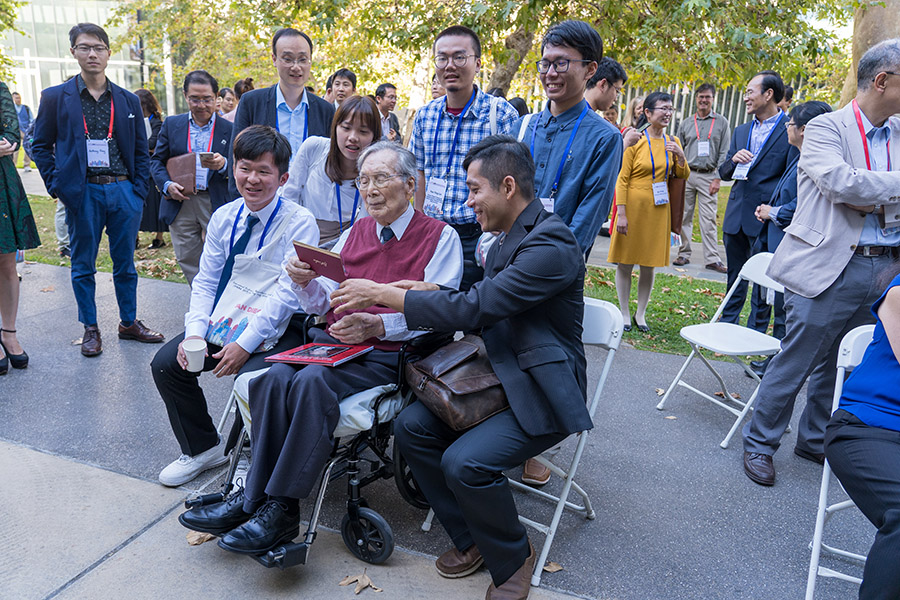
Fung examines a birthday card that a group of researchers gave him.
“My father was aware of how strong a scholar he was,” said Conrad Fung. “He didn’t have to struggle between spending time to figure research questions out and spending time sharing his knowledge. That was a great gift.”
Fung’s key principle was “Take it easy. But work hard,” said Conrad. It might sound like a paradox. But to Fung, it meant that it was important to set clear goals and keep those in mind while working hard without second-guessing and fretting. He passed this on to his students.
Ghassan Kassab was an undergraduate studying chemical engineering here on campus when he enrolled in biomechanics as a technical elective. Fung was teaching the class. “I recall he came to class empty-handed but before the lecture was over, the board was filled with well-proportioned conceptual drawings (he is an artist) or function of organs (he is a physiologist) with equations that described the concepts (he is a mathematician) and many deep insights that revealed the essence of the problem (he is a poet),” Kassab wrote in the book published for Fung’s 90th birthday.
Kassab went on to become one of Fung’s last Ph.D. students. He is now the founder and president of the California Medical Innovations Institute, a nonprofit dedicated to conducting basic and applied research to advance translation of diagnostics and therapeutics for the improvement of human health.
Fung as a mentor
Many of the Ph.D. students and postdoctoral researchers Fung mentored went on to lead bioengineering and biomedical engineering departments around the United States. Many have the same story: they heard Fung talk during a seminar and were instantly impressed. Often, they lingered after the talk and found that Fung was personable and easily approachable. Soon, they transferred to UC San Diego to be part of Fung’s research group.
Fung told his students that engineers should be able to turn any complicated problem into a simple problem.
“A problem is like a tree full of leaves in summer but loses all of them in fall so you can see things more clearly,” said Michael Yen, who was one of Fung’s Ph.D. students and postdocs before he joined the UC San Diego faculty. He was later recruited to start a biomedical engineering program at The University of Memphis. Fung also encouraged his students to be creative and do pioneering work, Yen said. “He told us to be like the spring flower that blooms first, before all others.”
Yen accompanied Fung on a trip to China. Fung had been asked to give a one-month lecture tour to help kick start bioengineering programs in that country after the end of the Cultural Revolution. “Everywhere we went, he wanted to help the poor and the needy,” Yen said. “I learned from him to be concerned about people’s humanity.”
Fung taught his graduate students by letting them explore and attempt to solve the problems by themselves, said Frank Yin, who was Fung's first Ph.D. student at UC San Diego. Fung, however, encouraged students to check in with him when they struggled. It’s a style that Yin adopted during his own career, first at Johns Hopkins and then at Washington University in St. Louis, where he led the biomedical engineering department from 1997 to 2013.
Fung’s legacy at UC San Diego
At UC San Diego, Fung’s legacy is upheld by many researchers, said bioengineering professor Geert Schmid-Schoenbein.
Shu Chien, who was recruited by Fung to come to UC San Diego from Columbia University, focuses on the study of how blood flow and pressure affect vessels. He earned a National Medal of Science in 2011. Chien wrote a 20-page academic paper on Fung’s legacy for his 100th birthday. “Through his vision of the power of ‘model making’ to explain and predict biological phenomena, Dr. Fung opened up a new vista for bioengineering,” Chien wrote.
For example, bioengineering professor Andrew McCulloch studies how stress in tissue impacts the heart, from heart muscle all the way down to individual cells and gene expression. Then McCulloch scales his findings back up, to the scale of the whole heart.
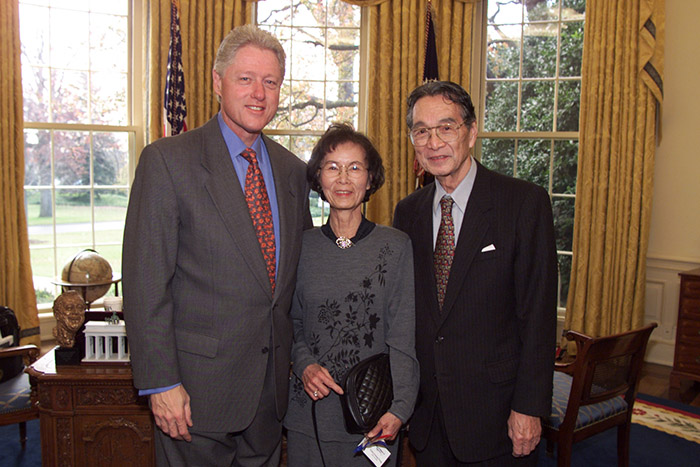
Fung and his wife with President Bill Clinton when he received the National Medal of Science in 2000.
Daniela Valdez-Jasso, who joined the UC San Diego bioengineering faculty in 2017, focuses on soft-tissue biomechanics and mathematical modeling at multiple scales of organ and tissue function, particularly as they relate to better understanding how heart ventricles adapt to pulmonary hypertension.
Schmid-Schoenbein himself is developing a new theory rooted in the foundations of biomechanics to explain how blood flow and organs fail in disease and before death, among many other research efforts. “Bert understood that you had to analyze living tissues with biomechanics to understand the course of a disease,” he said.
One of Fung’s grandchildren, Tony, is now a graduate student in bioengineering here on campus.
UC San Diego also was enriched by the efforts of Fung’s wife, Luna, who gave up her career as a mathematician and helped found and build up the International Center on campus, said Conrad. She passed away in 2017.
“She was the gentlest soul one could ever meet and a person of few, but essential, words,” Conrad and his sister, Brenda, wrote in the tribute book for Fung’s 90th birthday. “We like the image of our father traveling by ship, westbound from [China via] Calcutta, and of our mother also traveling by ship, eastbound from Shanghai, finally to meet again in the U.S. in a hug around the world.”
Share This:
You May Also Like
Stay in the Know
Keep up with all the latest from UC San Diego. Subscribe to the newsletter today.
